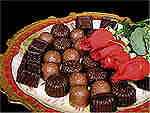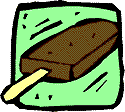Neuroscience For Kids
Discovering the Sweet Mysteries of Chocolate

By Ellen Kuwana
Neuroscience for Kids Staff Writer
Last updated: April 24, 2020
Chocolate History
 The ancient Mayans and Aztecs of the Americas consumed chocolate. These
people drank cacao, or the chocolate bean, which was ground into hot
water, like the hot chocolate we drink today. However, their cacao was
rather bitter and had chilies in it. For those of us who hoard our
chocolate candies, it is easy to understand why the Mayans and Aztecs used
cacao beans as currency. Imagine using candies instead of coins!
The ancient Mayans and Aztecs of the Americas consumed chocolate. These
people drank cacao, or the chocolate bean, which was ground into hot
water, like the hot chocolate we drink today. However, their cacao was
rather bitter and had chilies in it. For those of us who hoard our
chocolate candies, it is easy to understand why the Mayans and Aztecs used
cacao beans as currency. Imagine using candies instead of coins!
 How did chocolate spread around the world? In 1502, on his fourth and
last voyage to the New World, Christopher Columbus came upon a canoe that
was transporting agricultural products, including cacao beans. He seized
the contents of the canoe and brought cacao back to Spain. Chocolate did
not become popular for many years in Europe, but decades later, the
Spaniards added sugar to the cacao, and the rest, as they say, is history.
Chocolate soon became the preferred drink of the royal courts in Europe.
The belief was that chocolate could cure any illness.
How did chocolate spread around the world? In 1502, on his fourth and
last voyage to the New World, Christopher Columbus came upon a canoe that
was transporting agricultural products, including cacao beans. He seized
the contents of the canoe and brought cacao back to Spain. Chocolate did
not become popular for many years in Europe, but decades later, the
Spaniards added sugar to the cacao, and the rest, as they say, is history.
Chocolate soon became the preferred drink of the royal courts in Europe.
The belief was that chocolate could cure any illness.
Have you ever seen a cacao bean, (or, as it is more commonly known, a cocoa bean)? These beans grow on a tree called Theobroma cacao. The cacao tree is pollinated by insects called midges and is grown only within 10-20 degrees latitude of the Equator. These regions include West Africa, Central America, parts of South America, and the Caribbean Islands. The beans, which grow in the fruit pods of the tree, are generally harvested twice a year. Each pod is about the size of a hand and contains 20-50 beans. The pods turn bright yellow, orange, or red when ripe. The beans are dried, and then the center part is removed by hand and allowed to ferment. After the beans dry again, they are sold. The chocolate manufacturer must separate the beans from any debris, remove the hard outer shell, and grind the center part of the bean.
Chocolate, Chocolate Everywhere

 Chocolate candy bars, after-dinner mints, brownies, truffles, doughnuts,
chocolate milk - if it has chocolate in it, we eat it. Hot, cold, solid,
liquid, over ice cream...even over meat?! Yes, a Mexican sauce called
"mole" uses unsweetened chocolate in a sauce that is served over meat.
It's a versatile flavor, chocolate. Chocolate has been blamed for acne
and tooth decay, but research has found that it is innocent of these
evils. That must have made lots of people worldwide sigh in relief: the
chocolate industry sells five billion dollars worth of chocolate each year
in the U.S. alone. The U.S. is only the eighth largest consumer of
chocolate. Switzerland, whose citizens eat more than 21 pounds per person
each year, leads the world in chocolate consumption.
Chocolate candy bars, after-dinner mints, brownies, truffles, doughnuts,
chocolate milk - if it has chocolate in it, we eat it. Hot, cold, solid,
liquid, over ice cream...even over meat?! Yes, a Mexican sauce called
"mole" uses unsweetened chocolate in a sauce that is served over meat.
It's a versatile flavor, chocolate. Chocolate has been blamed for acne
and tooth decay, but research has found that it is innocent of these
evils. That must have made lots of people worldwide sigh in relief: the
chocolate industry sells five billion dollars worth of chocolate each year
in the U.S. alone. The U.S. is only the eighth largest consumer of
chocolate. Switzerland, whose citizens eat more than 21 pounds per person
each year, leads the world in chocolate consumption.
An Appetite for Chocolate
Why do we crave chocolate? There are times when nothing else tastes as
good as chocolate. There are times when you want nothing else. Nothing
 else will do. There's even a name for someone who craves chocolate: a
chocoholic. It's almost an uncontrollable urge.
else will do. There's even a name for someone who craves chocolate: a
chocoholic. It's almost an uncontrollable urge.
Some scientists wondered why the average person in the U.S. eats 11 pounds of chocolate each year. They decided to analyze the contents of chocolate to find out how those compounds might affect our brains, and thus our moods. Just as caffeine seems to perk people up, chocolate seems to make us feel happy.
Chocolate contains approximately 380 known chemicals, so it's no
wonder it's difficult to figure out why chocolate is such a favorite
 treat. And who's to say that it's only one or two things in chocolate that
cause us to feel happy? Many of the chemicals in chocolate are found in
other foods, yet we don't buy heart-shaped bananas to show that special
someone that we care for them. It may be a unique chemical combination
that gives chocolate its edge over vanilla, berry, and caramel. Although
chocolate has been said to improve mood, it contains saturated fat and
sugar, too, so don't overindulge - it's not the healthiest food. And keep
chocolate away from Spot! A two-ounce piece of chocolate can be fatal to a
dog because it can not digest one compound in chocolate called
theobromine. Chocolate can also make some small children sick for the same
reason.
treat. And who's to say that it's only one or two things in chocolate that
cause us to feel happy? Many of the chemicals in chocolate are found in
other foods, yet we don't buy heart-shaped bananas to show that special
someone that we care for them. It may be a unique chemical combination
that gives chocolate its edge over vanilla, berry, and caramel. Although
chocolate has been said to improve mood, it contains saturated fat and
sugar, too, so don't overindulge - it's not the healthiest food. And keep
chocolate away from Spot! A two-ounce piece of chocolate can be fatal to a
dog because it can not digest one compound in chocolate called
theobromine. Chocolate can also make some small children sick for the same
reason.
Chocolate and the Nervous System
 Adam Drewnowski at the University of Michigan researched whether chocolate
triggers the production of opioids. Opioids are chemicals, such as those
found in opium, that produce a feeling of well-being (euphoria).
Drewnowski found that eating chocolate causes the brain to produce natural
opiates, which dulI pain and increase a feeling of well-being. If the
receptors in the brain that signal the presence of opioids were blocked,
chocolate bingeing decreased. It was not shown, however, if this was
caused by the high fat or sugar content of chocolate candy.
Adam Drewnowski at the University of Michigan researched whether chocolate
triggers the production of opioids. Opioids are chemicals, such as those
found in opium, that produce a feeling of well-being (euphoria).
Drewnowski found that eating chocolate causes the brain to produce natural
opiates, which dulI pain and increase a feeling of well-being. If the
receptors in the brain that signal the presence of opioids were blocked,
chocolate bingeing decreased. It was not shown, however, if this was
caused by the high fat or sugar content of chocolate candy.
 Researchers at the Neurosciences Institute in San Diego, Emmanuelle
diTomaso (she's now at Harvard University) and Daniele Piomelli (he's now
at the University of California, Irvine) looked into the chemical
components of chocolate. They found three substances in
chocolate that "could act as cannabinoid mimics either directly (by
activating cannabinoid receptors) or indirectly (by increasing anandamide
levels)." What do all these big words mean? A little background
information may help make this more understandable.
Researchers at the Neurosciences Institute in San Diego, Emmanuelle
diTomaso (she's now at Harvard University) and Daniele Piomelli (he's now
at the University of California, Irvine) looked into the chemical
components of chocolate. They found three substances in
chocolate that "could act as cannabinoid mimics either directly (by
activating cannabinoid receptors) or indirectly (by increasing anandamide
levels)." What do all these big words mean? A little background
information may help make this more understandable.
 A receptor is a structure on the surface of a cell that interacts with
certain chemicals. Receptors have different shapes, and thus interact with
specific molecules. diTomaso describes this interaction like this: "the
active compound will lock itself to the protein and that triggers a
reaction inside the cell." Cannabinoids are substances that act like
cannabis, also known as marijuana. The active
chemical in marijuana is called tetrahydrocannabinol (THC), and there are
receptors in the brain that bind THC. When THC binds to these receptors,
the person feels "high." Anandamide is a lipid that is normally found in
the brain; it can bind to the same receptors as THC and thus produce a
similar effect to "being high."
A receptor is a structure on the surface of a cell that interacts with
certain chemicals. Receptors have different shapes, and thus interact with
specific molecules. diTomaso describes this interaction like this: "the
active compound will lock itself to the protein and that triggers a
reaction inside the cell." Cannabinoids are substances that act like
cannabis, also known as marijuana. The active
chemical in marijuana is called tetrahydrocannabinol (THC), and there are
receptors in the brain that bind THC. When THC binds to these receptors,
the person feels "high." Anandamide is a lipid that is normally found in
the brain; it can bind to the same receptors as THC and thus produce a
similar effect to "being high."
 Does chocolate affect the brain in the same way marijuana does?
There are chemicals in chocolate that act like THC, resulting in
production of dopamine, a neurotransmitter. However, there is no THC in
chocolate, so you aren't breaking the law by eating chocolate. One of the
compounds in chocolate is anandamide, which is already produced in your
brain. If anandamide is already in your brain, then why don't you feel
happy all the time? Well, anandamide is broken down quickly, so it isn't
around long in your brain to make you smile. But chocolate may extend the
feelings of well being. Piomelli's research indicates that there are two
chemicals in chocolate which inhibit the natural breakdown of anandamide.
This may be a reason why we like to eat chocolate! And dark chocolate
contains more of these compounds than milk chocolate.
Does chocolate affect the brain in the same way marijuana does?
There are chemicals in chocolate that act like THC, resulting in
production of dopamine, a neurotransmitter. However, there is no THC in
chocolate, so you aren't breaking the law by eating chocolate. One of the
compounds in chocolate is anandamide, which is already produced in your
brain. If anandamide is already in your brain, then why don't you feel
happy all the time? Well, anandamide is broken down quickly, so it isn't
around long in your brain to make you smile. But chocolate may extend the
feelings of well being. Piomelli's research indicates that there are two
chemicals in chocolate which inhibit the natural breakdown of anandamide.
This may be a reason why we like to eat chocolate! And dark chocolate
contains more of these compounds than milk chocolate.
Eating a bar of chocolate will not make you feel giddy or "high." This may be because anandamide and the two compounds that enhance its effect are short-lived and localized in the brain. THC activates many receptors throughout the brain, so it has a much larger effect. Chocolate's effect is limited because anandamide is not present all over the brain. Scientists doubt if anandamide and other chemicals in chocolate have much effect because they are present only in small amounts. Christian Felder at the National Institute of Mental Health estimates that a 130-pound person would have to eat 25 pounds of chocolate at one time to get any marijuana-like effect. Also, because these compounds are eaten, it's difficult to determine how much enters the bloodstream and actually reaches the brain.
There may also be other explanations for the feelings caused by chocolate and these may have nothing to do with cannabinoids, anandamide, or receptors. There are many other components in chocolate that may play a role in its popularity. Eating chocolate may be pleasurable because of a unique interaction among a few of its components.
 Chocolate also contains phenylethylamine, a chemical related to
amphetamines. Like amphetamines, this chemical causes blood pressure and
blood-sugar levels to rise, resulting in a feeling of alertness and
contentment. Phenylethylamine has been called the "love-drug" because it
quickens your pulse, as if you are in love. Caffeine in chocolate may
also cause feelings of alertness and a pounding heart. Other stimulants in
chocolate include theobromine and methylxanthines. These
caffeine-relatives are weaker than caffeine-you'd have to eat more than 12
Hershey bars to get as much caffeine as there is in one cup of coffee. All
of these stimulants increase the activity of neurotransmitters in the
brain.
Chocolate also contains phenylethylamine, a chemical related to
amphetamines. Like amphetamines, this chemical causes blood pressure and
blood-sugar levels to rise, resulting in a feeling of alertness and
contentment. Phenylethylamine has been called the "love-drug" because it
quickens your pulse, as if you are in love. Caffeine in chocolate may
also cause feelings of alertness and a pounding heart. Other stimulants in
chocolate include theobromine and methylxanthines. These
caffeine-relatives are weaker than caffeine-you'd have to eat more than 12
Hershey bars to get as much caffeine as there is in one cup of coffee. All
of these stimulants increase the activity of neurotransmitters in the
brain.
Whatever the true reason for chocolate's popularity, scientists will continue to investigate the sweet mysteries of cacao. In the meantime, grab a bar for yourself and a box for your Valentine.
Life is sweeter with
chocolate.

 Hear It |
"Opioid" | "Cannabinoid" |
References and more information about chocolate:
- Brain Cannabinoids in Chocolate, Nature, August 22, 1996, pp. 677-678 by diTomaso, E., Beltramo, M., and Piomelli, D.
- Chocolate: the Legal 'High', August 21, 1996, Medical Tribune News Service by Mann, D.
- Marijuana and Chocolate, AIDS Treatment News 257-October 18, 1996 by James, J.S.
- The Sweet Lure of Chocolate - All about the history of chocolate and research about its effects, plus a list of references and related links.
- The Science of Love - Research into why we love chocolate.
- Trick or Treat from Food Endocannabinoids?, Nature, Vol. 396, December 17, 1998, pp. 636-637, by DiMarzo, Sepe, DePetrocellis, Berger, Crozier, Fride and Mechoulam - A letter to Nature raising questions and concerns about the original report of endocannabinoids in chocolate, plus a reply by two of the authors of the report, Beltramo and Piomelli.
- Claims About Cocoa - NIH News in Health, August, 2011
Copyright © 1996-2011, Eric H. Chudler All Rights Reserved.
